Fitzgerald A.E. Electric Machinery
Подождите немного. Документ загружается.

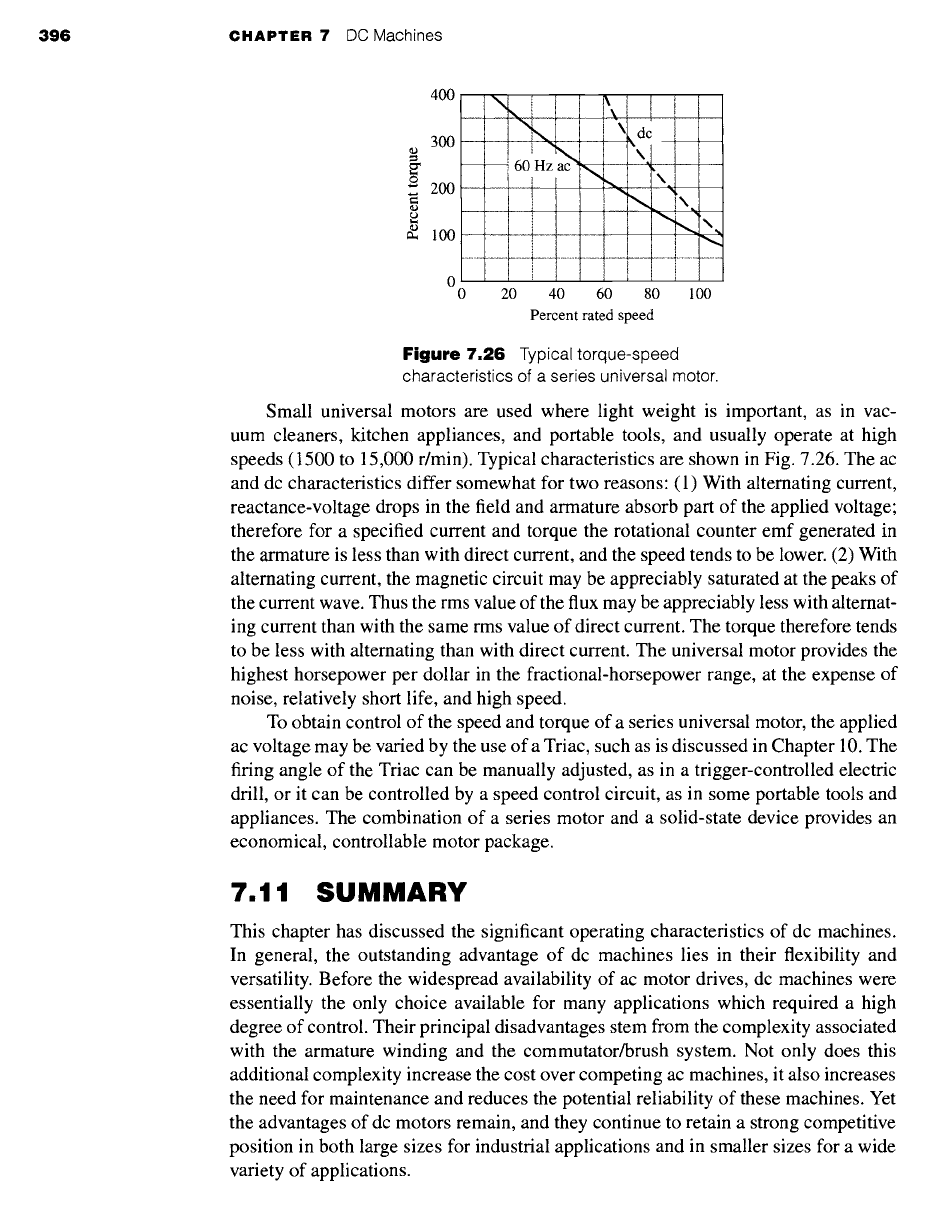
396 CHAPTER 7 DC Machines
400
300
E
o
: 200
~9
100
\. i
60 Hz
i J
J i
20 40
\ dc
" "'4
60 80 1 O0
Percent rated speed
Figure
7.26 Typical torque-speed
characteristics of a series universal motor.
Small universal motors are used where light weight is important, as in vac-
uum cleaners, kitchen appliances, and portable tools, and usually operate at high
speeds (1500 to 15,000 r/min). Typical characteristics are shown in Fig. 7.26. The ac
and dc characteristics differ somewhat for two reasons: (1) With alternating current,
reactance-voltage drops in the field and armature absorb part of the applied voltage;
therefore for a specified current and torque the rotational counter emf generated in
the armature is less than with direct current, and the speed tends to be lower. (2) With
alternating current, the magnetic circuit may be appreciably saturated at the peaks of
the current wave. Thus the rms value of the flux may be appreciably less with alternat-
ing current than with the same rms value of direct current. The torque therefore tends
to be less with alternating than with direct current. The universal motor provides the
highest horsepower per dollar in the fractional-horsepower range, at the expense of
noise, relatively short life, and high speed.
To obtain control of the speed and torque of a series universal motor, the applied
ac voltage may be varied by the use of a Triac, such as is discussed in Chapter 10. The
firing angle of the Triac can be manually adjusted, as in a trigger-controlled electric
drill, or it can be controlled by a speed control circuit, as in some portable tools and
appliances. The combination of a series motor and a solid-state device provides an
economical, controllable motor package.
7.11 SUMMARY
This chapter has discussed the significant operating characteristics of dc machines.
In general, the outstanding advantage of dc machines lies in their flexibility and
versatility. Before the widespread availability of ac motor drives, dc machines were
essentially the only choice available for many applications which required a high
degree of control. Their principal disadvantages stem from the complexity associated
with the armature winding and the commutator/brush system. Not only does this
additional complexity increase the cost over competing ac machines, it also increases
the need for maintenance and reduces the potential reliability of these machines. Yet
the advantages of dc motors remain, and they continue to retain a strong competitive
position in both large sizes for industrial applications and in smaller sizes for a wide
variety of applications.

7.12 Problems 397
Dc generators are a simple solution to the problem of converting mechanical
energy to electric energy in dc form, although ac generators feeding rectifier systems
are certainly an option which must be considered. Among dc generators themselves,
separately-excited and cumulatively-compounded, self-excited machines are the most
common. Separately-excited generators have the advantage of permitting a wide range
of output voltages, whereas self-excited machines may produce unstable voltages at
lower output voltages where the field-resistance line becomes essentially tangent
to the magnetization curve. Cumulatively-compounded generators may produce a
substantially flat voltage characteristic or one which rises with load, whereas shunt-
or separately-excited generators may produce a drooping voltage characteristic unless
external regulating means (such as a series field winding) are added.
Among dc motors, the outstanding characteristics of each type are as follows. The
series motor operates with a decidedly drooping speed as load is added, the no-load
speed usually being prohibitively high; the torque is proportional to almost the square
of the current at low flux levels and to some power between 1 and 2 as saturation
increases. The shunt motor at constant field current operates at a slightly drooping
but almost constant speed as load is added, the torque being almost proportional
to armature current; equally important, however, is the fact that its speed can be
controlled over wide ranges by shunt-field control, armature-voltage control, or a
combination of both. Depending on the relative strengths of the shunt and series field,
the cumulatively-compounded motor is intermediate between the other two and may
be given essentially the advantages of one or the other.
In a wide variety of low-power applications in systems which are run from a
dc source (automotive applications, portable electronics, etc.), dc machines are the
most cost-effective choice. These dc machines are constructed in a wide-range of
configurations, and many of them are based upon permanent-magnet excitation. In
spite of the wide variety of dc machines which can be found in these various applica-
tions, their performance can readily be determined using the models and techniques
presented in this chapter.
7.12 PROBLEMS
7.1 Consider a separately-excited dc motor. Describe the speed variation of the
motor operating unloaded under the following conditions:
a. The armature terminal voltage is varied while the field current is held
constant.
b. The field current is varied while the armature terminal voltage is held
constant.
c. The field winding is connected in shunt directly to the armature terminals,
and the armature terminal voltage is then varied.
7.2 A dc shunt motor operating at an armature terminal voltage of 125 V is
observed to be operating at a speed of 1180 r/min. When the motor is operated
unloaded at the same armature terminal voltage but with an additional
resistance of 5 f2 in series with the shunt field, the motor speed is observed to
be 1250 r/min.
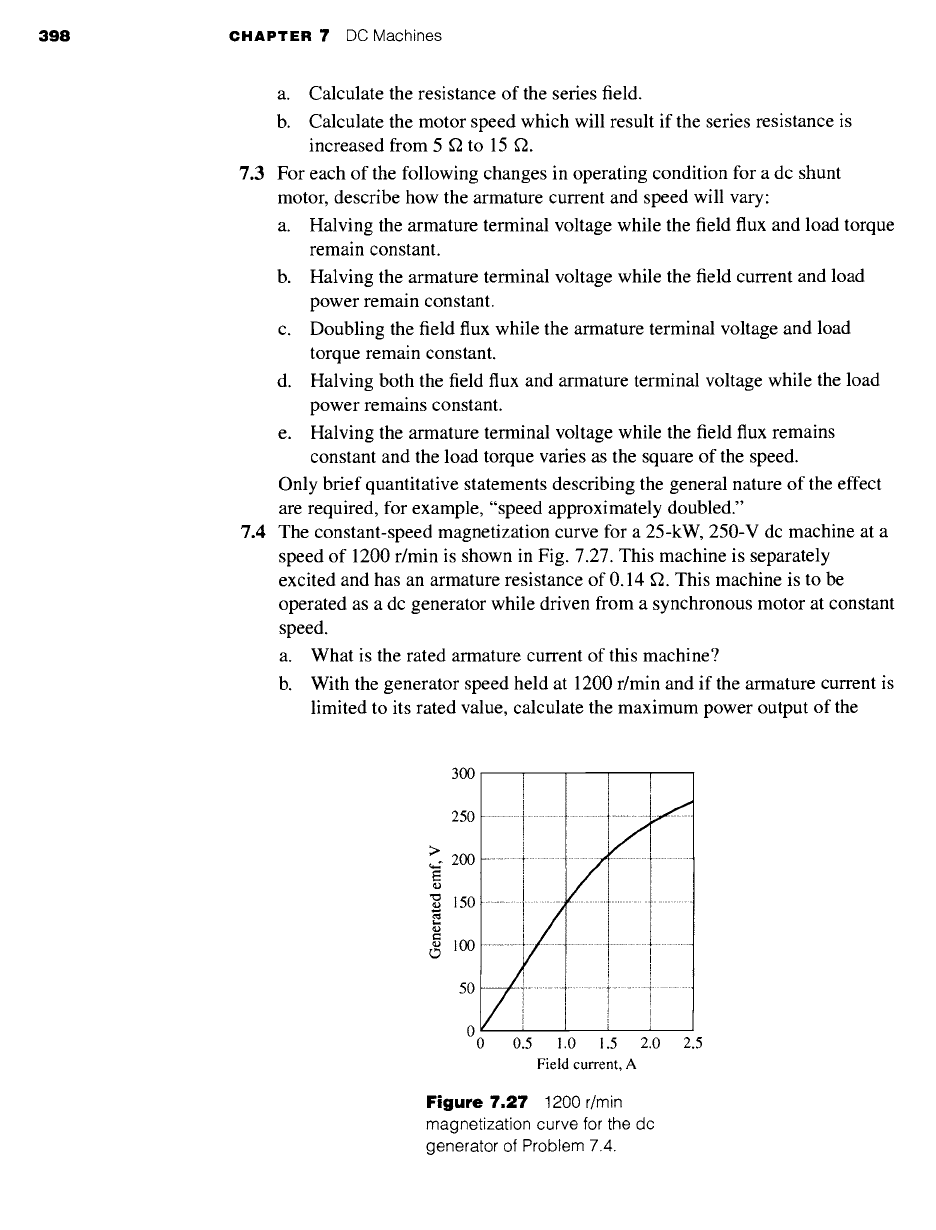
398 CHAPTER 7 DC Machines
a. Calculate the resistance of the series field.
b. Calculate the motor speed which will result if the series resistance is
increased from 5 f2 to 15 f2.
7.3 For each of the following changes in operating condition for a dc shunt
motor, describe how the armature current and speed will vary:
a. Halving the armature terminal voltage while the field flux and load torque
remain constant.
b. Halving the armature terminal voltage while the field current and load
power remain constant.
c. Doubling the field flux while the armature terminal voltage and load
torque remain constant.
d. Halving both the field flux and armature terminal voltage while the load
power remains constant.
e. Halving the armature terminal voltage while the field flux remains
constant and the load torque varies as the square of the speed.
Only brief quantitative statements describing the general nature of the effect
are required, for example, "speed approximately doubled."
7.4 The constant-speed magnetization curve for a 25-kW, 250-V dc machine at a
speed of 1200 r/min is shown in Fig. 7.27. This machine is separately
excited and has an armature resistance of 0.14 f2. This machine is to be
operated as a dc generator while driven from a synchronous motor at constant
speed.
a. What is the rated armature current of this machine?
b. With the generator speed held at 1200 r/min and if the armature current is
limited to its rated value, calculate the maximum power output of the
300
250
>
200
E
~D
150
~D
100
r~
50
0
0
................ .......................... .......................... .........................
........................ I I
0.5 1.0 1.5 2.0 2.5
Field current, A
Figure
7.27 1200 r/min
magnetization curve for the dc
generator of Problem 7.4.
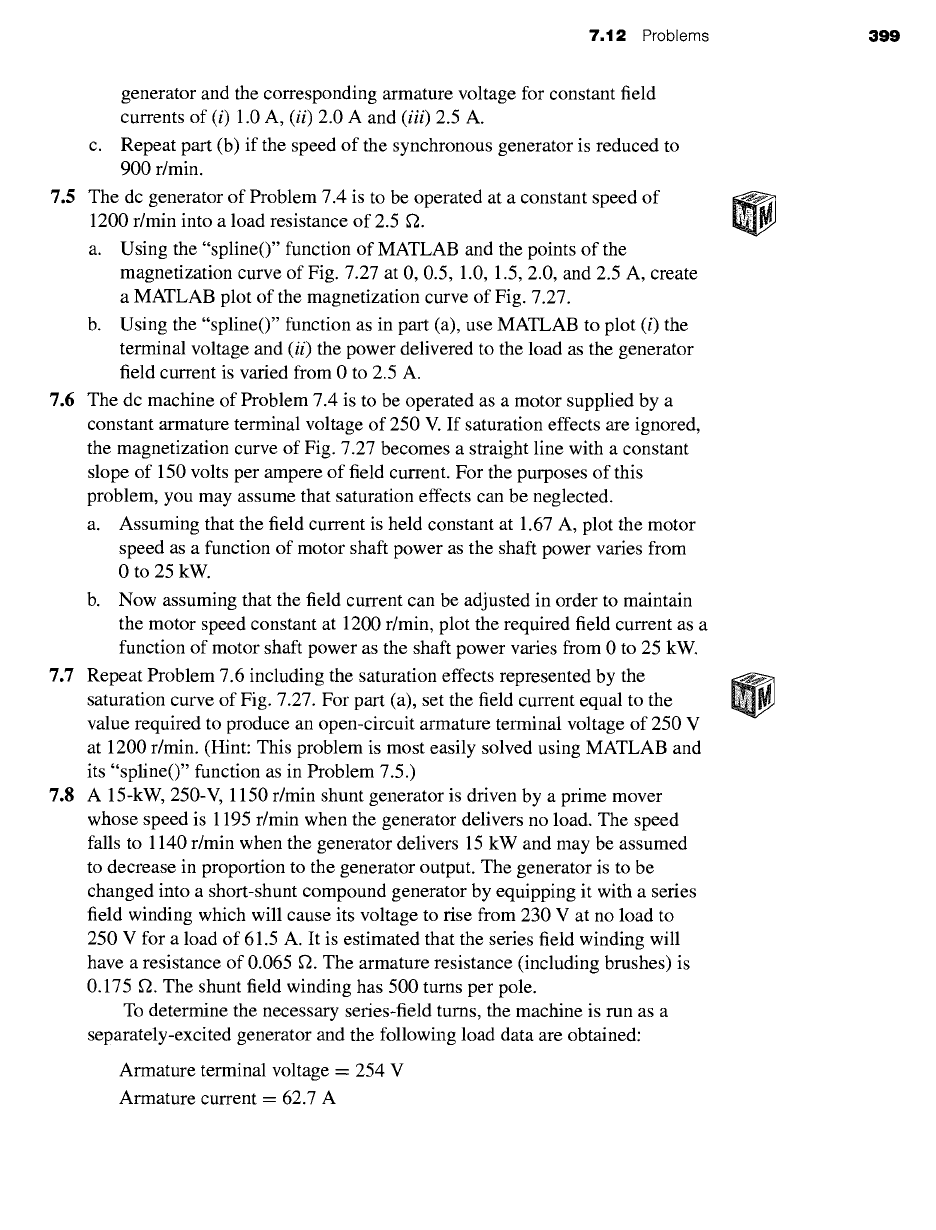
7,12 Problems 399
generator and the corresponding armature voltage for constant field
currents of (i) 1.0 A,
(ii)
2.0 A and
(iii)
2.5 A.
c. Repeat part (b) if the speed of the synchronous generator is reduced to
900 r/min.
7.5 The dc generator of Problem 7.4 is to be operated at a constant speed of
1200 r/min into a load resistance of 2.5 f2.
a. Using the "spline0" function of MATLAB and the points of the
magnetization curve of Fig. 7.27 at 0, 0.5, 1.0, 1.5, 2.0, and 2.5 A, create
a MATLAB plot of the magnetization curve of Fig. 7.27.
b. Using the "spline0" function as in part (a), use MATLAB to plot (i) the
terminal voltage and
(ii)
the power delivered to the load as the generator
field current is varied from 0 to 2.5 A.
7.6 The dc machine of Problem 7.4 is to be operated as a motor supplied by a
constant armature terminal voltage of 250 V. If saturation effects are ignored,
the magnetization curve of Fig. 7.27 becomes a straight line with a constant
slope of 150 volts per ampere of field current. For the purposes of this
problem, you may assume that saturation effects can be neglected.
a. Assuming that the field current is held constant at 1.67 A, plot the motor
speed as a function of motor shaft power as the shaft power varies from
0 to 25 kW.
b. Now assuming that the field current can be adjusted in order to maintain
the motor speed constant at 1200 r/min, plot the required field current as a
function of motor shaft power as the shaft power varies from 0 to 25 kW.
7.7 Repeat Problem 7.6 including the saturation effects represented by the
saturation curve of Fig. 7.27. For part (a), set the field current equal to the
value required to produce an open-circuit armature terminal voltage of 250 V
at 1200 r/min. (Hint: This problem is most easily solved using MATLAB and
its "spline0" function as in Problem 7.5.)
7.8 A 15-kW, 250-V, 1150 r/min shunt generator is driven by a prime mover
whose speed is 1195 r/min when the generator delivers no load. The speed
falls to 1140 r/min when the generator delivers 15 kW and may be assumed
to decrease in proportion to the generator output. The generator is to be
changed into a short-shunt compound generator by equipping it with a series
field winding which will cause its voltage to rise from 230 V at no load to
250 V for a load of 61.5 A. It is estimated that the series field winding will
have a resistance of 0.065 S2. The armature resistance (including brushes) is
0.175 f2. The shunt field winding has 500 turns per pole.
To determine the necessary series-field turns, the machine is run as a
separately-excited generator and the following load data are obtained:
Armature terminal voltage = 254 V
Armature current = 62.7 A
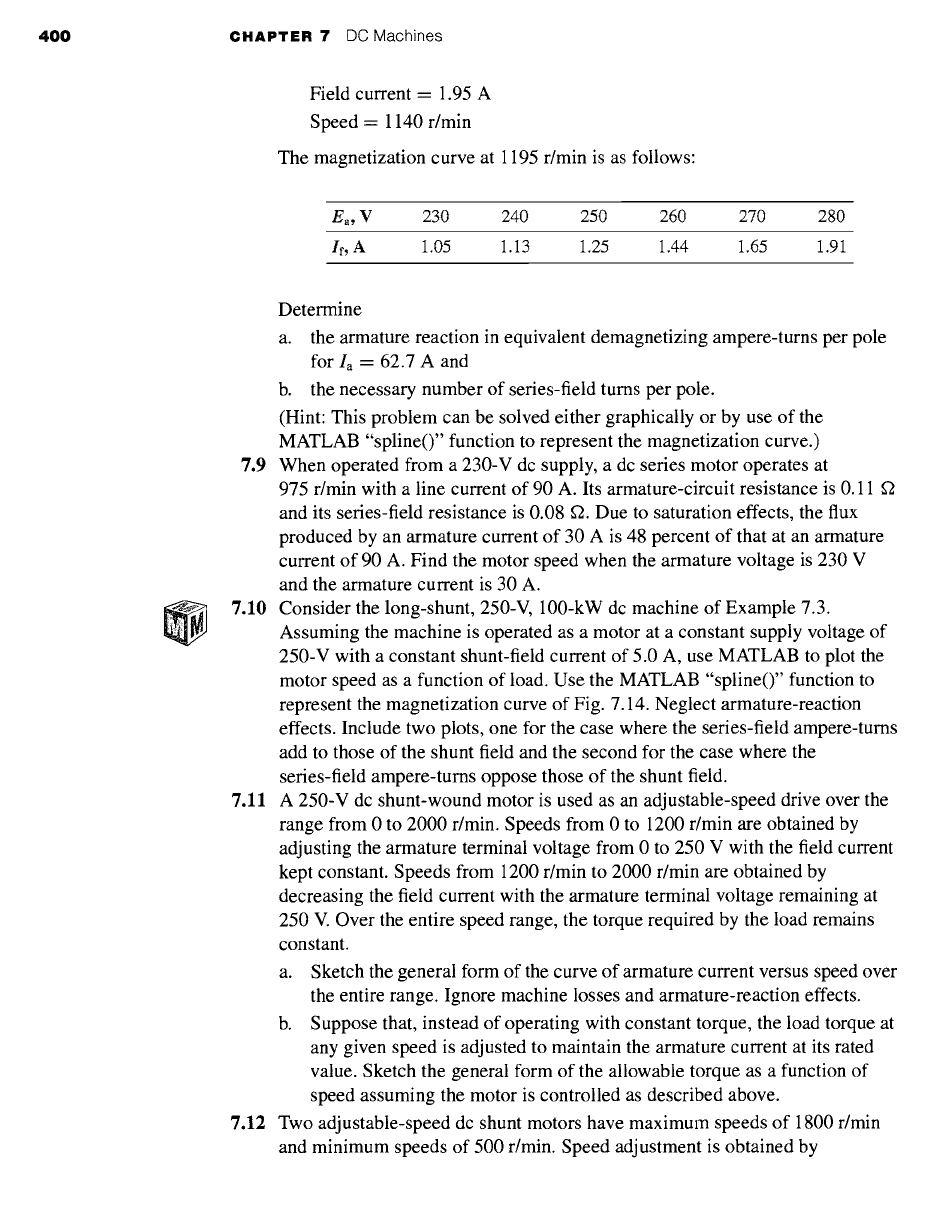
400 CHAPTER 7 DC Machines
Field current = 1.95 A
Speed = 1140 r/min
The magnetization curve at 1195 r/min is as follows:
Ea,
V 230 240 250 260 270 280
Ir, A 1.05 1.13 1.25 1.44 1.65 1.91
Determine
a. the armature reaction in equivalent demagnetizing ampere-turns per pole
for Ia = 62.7 A and
b. the necessary number of series-field turns per pole.
(Hint: This problem can be solved either graphically or by use of the
MATLAB "spline()" function to represent the magnetization curve.)
7.9 When operated from a 230-V dc supply, a dc series motor operates at
975 r/min with a line current of 90 A. Its armature-circuit resistance is 0.11 f2
and its series-field resistance is 0.08 f2. Due to saturation effects, the flux
produced by an armature current of 30 A is 48 percent of that at an armature
current of 90 A. Find the motor speed when the armature voltage is 230 V
and the armature current is 30 A.
7.10 Consider the long-shunt, 250-V, 100-kW dc machine of Example 7.3.
Assuming the machine is operated as a motor at a constant supply voltage of
250-V with a constant shunt-field current of 5.0 A, use MATLAB to plot the
motor speed as a function of load. Use the MATLAB "spline()" function to
represent the magnetization curve of Fig. 7.14. Neglect armature-reaction
effects. Include two plots, one for the case where the series-field ampere-turns
add to those of the shunt field and the second for the case where the
series-field ampere-turns oppose those of the shunt field.
7.11 A 250-V dc shunt-wound motor is used as an adjustable-speed drive over the
range from 0 to 2000 r/min. Speeds from 0 to 1200 r/min are obtained by
adjusting the armature terminal voltage from 0 to 250 V with the field current
kept constant. Speeds from 1200 r/min to 2000 r/min are obtained by
decreasing the field current with the armature terminal voltage remaining at
250 V. Over the entire speed range, the torque required by the load remains
constant.
a. Sketch the general form of the curve of armature current versus speed over
the entire range. Ignore machine losses and armature-reaction effects.
b. Suppose that, instead of operating with constant torque, the load torque at
any given speed is adjusted to maintain the armature current at its rated
value. Sketch the general form of the allowable torque as a function of
speed assuming the motor is controlled as described above.
7.12 Two adjustable-speed dc shunt motors have maximum speeds of 1800 r/min
and minimum speeds of 500 r/min. Speed adjustment is obtained by
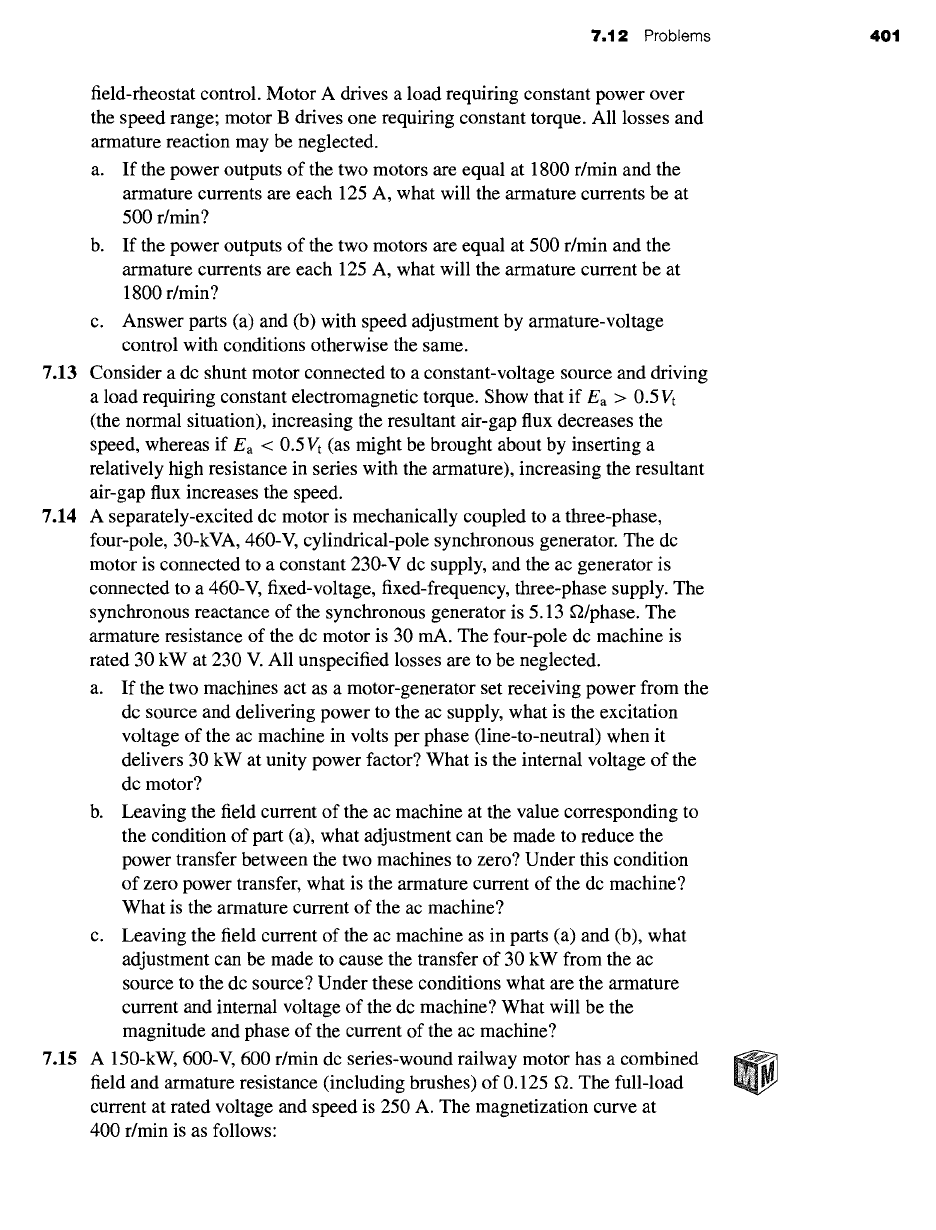
7.12 Problems
401
field-rheostat control. Motor A drives a load requiring constant power over
the speed range; motor B drives one requiring constant torque. All losses and
armature reaction may be neglected.
a. If the power outputs of the two motors are equal at 1800 r/min and the
armature currents are each 125 A, what will the armature currents be at
500 r/min?
b. If the power outputs of the two motors are equal at 500 r/min and the
armature currents are each 125 A, what will the armature current be at
1800 r/min?
c. Answer parts (a) and (b) with speed adjustment by armature-voltage
control with conditions otherwise the same.
7.13 Consider a dc shunt motor connected to a constant-voltage source and driving
a load requiring constant electromagnetic torque. Show that if Ea > 0.5Vt
(the normal situation), increasing the resultant air-gap flux decreases the
speed, whereas if Ea < 0.5 Vt (as might be brought about by inserting a
relatively high resistance in series with the armature), increasing the resultant
air-gap flux increases the speed.
7.14 A separately-excited dc motor is mechanically coupled to a three-phase,
four-pole, 30-kVA, 460-V, cylindrical-pole synchronous generator. The dc
motor is connected to a constant 230-V dc supply, and the ac generator is
connected to a 460-V, fixed-voltage, fixed-frequency, three-phase supply. The
synchronous reactance of the synchronous generator is 5.13 f2/phase. The
armature resistance of the dc motor is 30 mA. The four-pole dc machine is
rated 30 kW at 230 V. All unspecified losses are to be neglected.
a. If the two machines act as a motor-generator set receiving power from the
dc source and delivering power to the ac supply, what is the excitation
voltage of the ac machine in volts per phase (line-to-neutral) when it
delivers 30 kW at unity power factor? What is the internal voltage of the
dc motor?
b. Leaving the field current of the ac machine at the value corresponding to
the condition of part (a), what adjustment can be made to reduce the
power transfer between the two machines to zero? Under this condition
of zero power transfer, what is the armature current of the dc machine?
What is the armature current of the ac machine?
c. Leaving the field current of the ac machine as in parts (a) and (b), what
adjustment can be made to cause the transfer of 30 kW from the ac
source to the dc source? Under these conditions what are the armature
current and internal voltage of the dc machine? What will be the
magnitude and phase of the current of the ac machine?
7.15 A 150-kW, 600-V, 600 r/min dc series-wound railway motor has a combined
field and armature resistance (including brushes) of 0.125 f2. The full-load
current at rated voltage and speed is 250 A. The magnetization curve at
400 r/min is as follows:
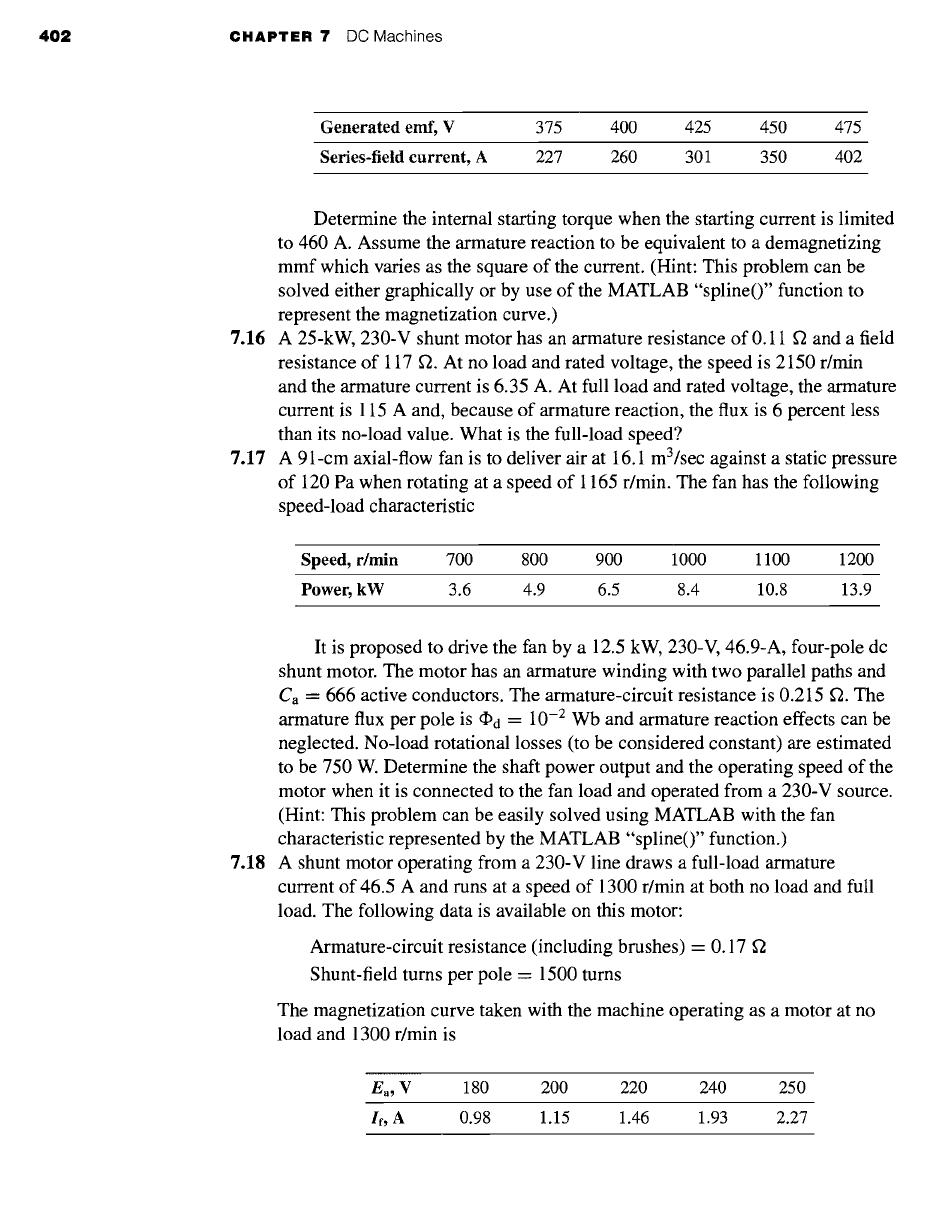
402 CHAPTER 7 DC Machines
Generated emf, V 375 400 425 450 475
Series-field current, A 227 260 301 350 402
Determine the internal starting torque when the starting current is limited
to 460 A. Assume the armature reaction to be equivalent to a demagnetizing
mmf which varies as the square of the current. (Hint: This problem can be
solved either graphically or by use of the MATLAB "spline0" function to
represent the magnetization curve.)
7.16 A 25-kW, 230-V shunt motor has an armature resistance of 0.11 ~2 and a field
resistance of 117 ~. At no load and rated voltage, the speed is 2150 r/min
and the armature current is 6.35 A. At full load and rated voltage, the armature
current is 115 A and, because of armature reaction, the flux is 6 percent less
than its no-load value. What is the full-load speed?
7.17 A 91-cm axial-flow fan is to deliver air at 16.1 m3/sec against a static pressure
of 120 Pa when rotating at a speed of 1165 r/min. The fan has the following
speed-load characteristic
Speed, r/rain 700 800 900 1000 1100 1200
Power, kW 3.6 4.9 6.5 8.4 10.8 13.9
It is proposed to drive the fan by a 12.5 kW, 230-V, 46.9-A, four-pole dc
shunt motor. The motor has an armature winding with two parallel paths and
Ca = 666 active conductors. The armature-circuit resistance is 0.215 ~. The
armature flux per pole is ~d = 10 -2 Wb and armature reaction effects can be
neglected. No-load rotational losses (to be considered constant) are estimated
to be 750 W. Determine the shaft power output and the operating speed of the
motor when it is connected to the fan load and operated from a 230-V source.
(Hint: This problem can be easily solved using MATLAB with the fan
characteristic represented by the MATLAB "spline()" function.)
7.18 A shunt motor operating from a 230-V line draws a full-load armature
current of 46.5 A and runs at a speed of 1300 r/min at both no load and full
load. The following data is available on this motor:
Armature-circuit resistance (including brushes) = 0.17 f2
Shunt-field turns per pole -- 1500 turns
The magnetization curve taken with the machine operating as a motor at no
load and 1300 r/min is
E,, V 180 200 220 240 250
It., A 0.98 1.15 1.46 1.93 2.27
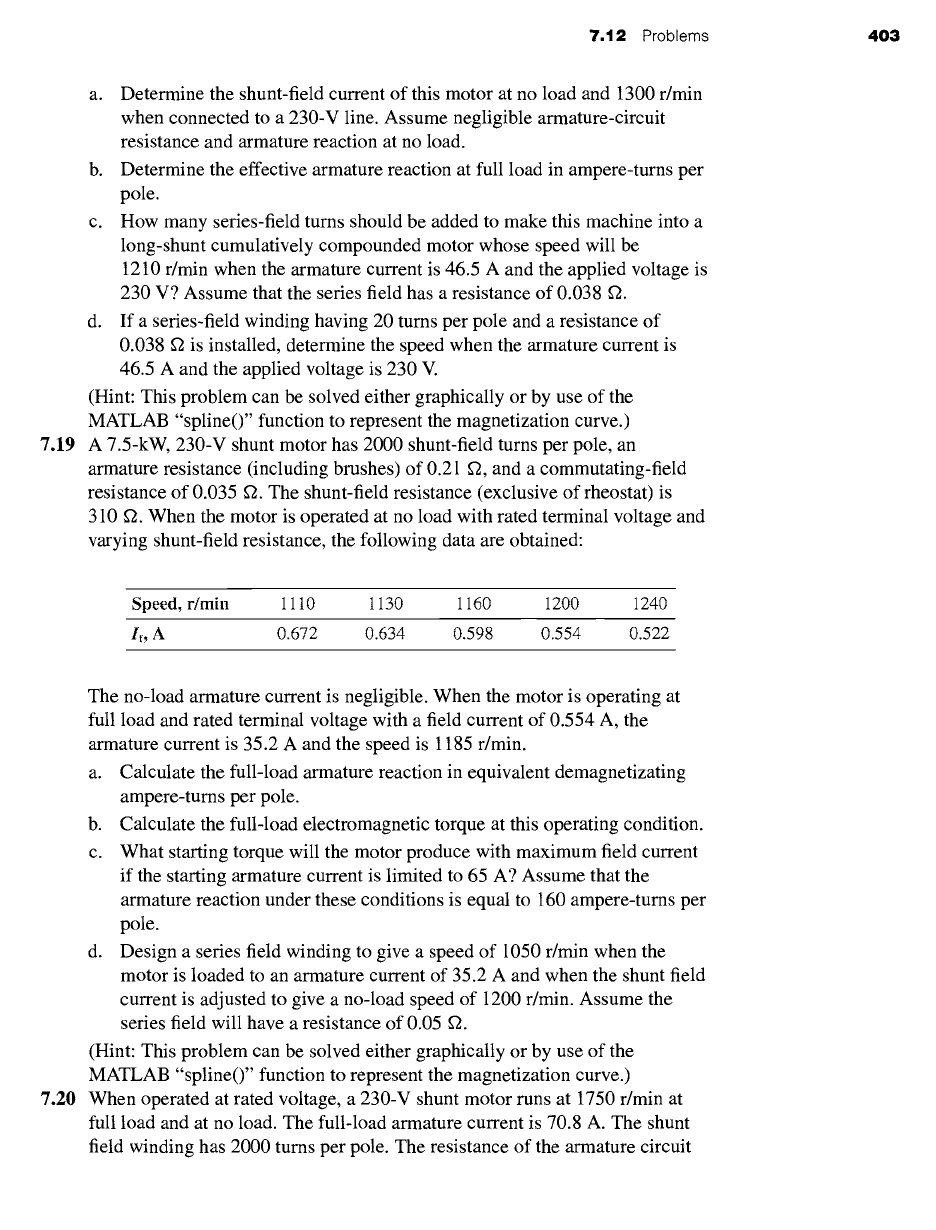
7.12 Problems
403
a. Determine the shunt-field current of this motor at no load and 1300 r/min
when connected to a 230-V line. Assume negligible armature-circuit
resistance and armature reaction at no load.
b. Determine the effective armature reaction at full load in ampere-turns per
pole.
c. How many series-field turns should be added to make this machine into a
long-shunt cumulatively compounded motor whose speed will be
1210 r/min when the armature current is 46.5 A and the applied voltage is
230 V? Assume that the series field has a resistance of 0.038 f2.
d. If a series-field winding having 20 turns per pole and a resistance of
0.038 f2 is installed, determine the speed when the armature current is
46.5 A and the applied voltage is 230 V.
(Hint: This problem can be solved either graphically or by use of the
MATLAB "spline0" function to represent the magnetization curve.)
7.19 A 7.5-kW, 230-V shunt motor has 2000 shunt-field turns per pole, an
armature resistance (including brushes) of 0.21 f2, and a commutating-field
resistance of 0.035 f2. The shunt-field resistance (exclusive of rheostat) is
310 f2. When the motor is operated at no load with rated terminal voltage and
varying shunt-field resistance, the following data are obtained:
Speed, r/min 1110 1130 1160 1200 1240
if, A 0.672 0.634 0.598 0.554 0.522
The no-load armature current is negligible. When the motor is operating at
full load and rated terminal voltage with a field current of 0.554 A, the
armature current is 35.2 A and the speed is 1185 r/min.
a. Calculate the full-load armature reaction in equivalent demagnetizating
ampere-turns per pole.
b. Calculate the full-load electromagnetic torque at this operating condition.
c. What starting torque will the motor produce with maximum field current
if the starting armature current is limited to 65 A? Assume that the
armature reaction under these conditions is equal to 160 ampere-turns per
pole.
d. Design a series field winding to give a speed of 1050 r/min when the
motor is loaded to an armature current of 35.2 A and when the shunt field
current is adjusted to give a no-load speed of 1200 r/min. Assume the
series field will have a resistance of 0.05 f2.
(Hint: This problem can be solved either graphically or by use of the
MATLAB "spline0" function to represent the magnetization curve.)
7.20 When operated at rated voltage, a 230-V shunt motor runs at 1750 r/min at
full load and at no load. The full-load armature current is 70.8 A. The shunt
field winding has 2000 turns per pole. The resistance of the armature circuit

404 CHAPTER 7 DC Machines
(including brushes and interpoles) is 0.15 f2. The magnetization curve at
1750 r/min is
E,, V 200 210 220 230 240 250
It,, A 0.40 0.44 0.49 0.55 0.61 0.71
a. Compute the demagnetizing effect of the armature reaction at full load.
b. A long-shunt cumulative series field winding having four turns per pole
and a resistance of 0.038 f2 is added to the machine. Compute the speed
at full-load current and rated voltage. The shunt field current will remain
equal to that of part (a).
c. With the series-field winding of part (b) installed, compute the internal
starting torque in N. m if the starting armature current is limited to 125 A.
Assume that the corresponding demagnetizating effect of armature
reaction is 230 ampere-turns per pole.
(Hint: This problem can be solved either graphically or by use of the
MATLAB "spline0" function to represent the magnetization curve.)
7.21 A 230-V dc shunt motor has an armature-circuit resistance of 0.23 f2. When
operating from a 230-V supply and driving a constant-torque load, the motor
is observed to be drawing an armature current of 60 A. An external resistance
of 1.0 f2 is now inserted in series with the armature while the shunt field
current is unchanged. Neglecting the effects of rotational losses and armature
reaction, calculate
a. the resultant armature current and
b. the fractional speed change of the motor.
7.22 A common industrial application of dc series motors is in crane and hoist
drives. This problem relates to the computation of selected motor
performance characterstics for such a drive. The specific motor concerned is
a series-wound, 230-V, totally-enclosed motor having a 1/2-hour crane rating
of 100 kW with a 75°C temperature rise. The performance characteristics
Table 7.1
Motor characteristics for
Problem 7.22.
Line current Shaft torque Speed
A N. m r/min
100 217 940
200 570 630
300 1030 530
400 1480 475
500 1980 438
600 2470 407
700 3000 385
800 3430 370

7.12 Problems
405
Series
R2 Field
(a) (b)
Figure 7.28
Series crane motor (Problem 7.22): (a) hoisting connection and
(b) lowering connection.
of the motor alone at 230 V as found in the manufacturer's catalog are listed
in Table 7.1. The resistance of the armature (including brushes) plus
commutating winding is 0.065 ~ and that of the series field winding is
0.027 ~. Armature reaction effects can be ignored.
The motor is to be connected as in Fig. 7.28a for hoisting and Fig. 7.28b
for lowering. The former connection consists simply of series-resistance
control. The latter connection provides dynamic breaking with the field
reconnected in shunt with the addition of an adjustable series resistance.
You will use MATLAB to plot some sample speed-torque curves (speed
as a function of torque) to determine the suitability of the motor and control
for the specified application. Plot all of the curves on a single set of axes
coveting roughly the torque-magnitude range found in Table 7.1. Provide for
both positive and negative values of speed, corresponding respectively to
hoisting and lowering, as well as for both positive and negative values of
torque, corresponding respectively to torque in the direction of raising the
load and torque in the direction of lowering the load.
a. For the hoisting connection, plot speed-torque curves for the control
resistor Rc set at 0, 0.3 and 0.6 f2. If any of these curves extend into the
fourth quadrant within the range of torques covered, interpret physically
what operation in that regime means.
b. For the lowering connection, plot a speed-torque curve for R1 = 0.3 f2
and R2 = 0.3 f2. The most important portion of this curve is in the fourth
quadrant, but if it extends into the third quadrant, that region should also
be plotted and interpreted physically.
c. In part (b), what is the lowering speed corresponding to a torque of
1500 N. m? (Hint: This can be found easily using the MATLAB
"spline0" function.)
7.23 A 25-kW, 230-V shunt motor has an armature resistance of 0.064 f2 and a
field-circuit resistance of 95 f2. The motor delivers rated output power at
rated voltage when its armature current is 122 A. When the motor is
operating at rated voltage, the speed is observed to be 1150 r/min when the
machine is loaded such that the armature current is 69.5 A.
